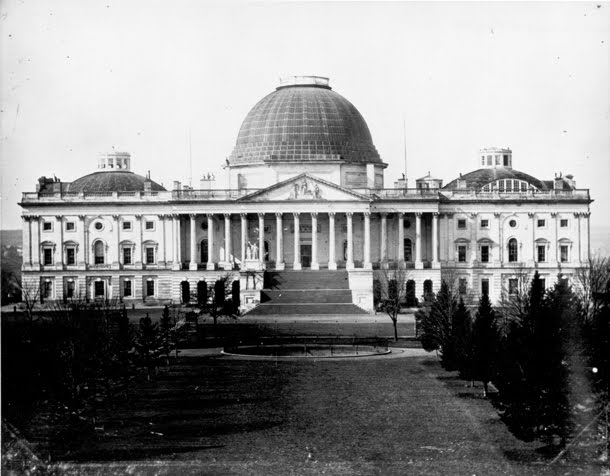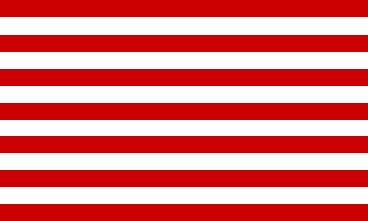From Lew Rockwell.com:
The Federal Reserve's Reserve
by Gary North
by Gary North
Recently by Gary North: Communism for Conservatives
Every army keeps troops in reserve. If there is a breakthrough in the defensive line by the enemy army, the commanding general needs reserves to send into the breach to keep his army from being routed. It is too risky not to have reserves.
The Federal Reserve System's reserves are digits. At any time, it can create digital entries on its balance sheet by purchasing assets. This increases the monetary base. The FED used these reserves in October of 2008, when the world's financial system was poised at the edge of the abyss. It doubled the adjusted monetary base in a short period of time. The chart is here. It is the chart at the top of the page.
I argue that the FED is keeping digits in reserve. It refuses to activate them. These reserves have a strategic function. They are to be used only in the case of a major threat to the financial system – the economic equivalent of a breach in the line.
The FED is allowing the economy to readjust to the new conditions of supply and demand. These conditions are presently a slowdown in economic growth. The V-shaped recovery had been widely expected by Keynesian financial commentators. The size of the two fiscal stimuli – one by Bush and one by Obama – almost back to back was expected to accomplish the old Keynesian green magic: recovery. They have failed to restore anything remotely resembling the pre-2008 boom. The economy is losing steam.
The commercial banks are the cause of this reduction in consumer demand. The bankers are afraid to lend. But the FED is also to blame. It could inflate the monetary base far more than it has. It could purchase assets of all kinds, including financial futures. There is no legal limit to what the FED is allowed to purchase. This has been true for 30 years.
Why isn't the FED inflating? Because it is holding digits in reserve for a strategic reason: to cut off all traces of price inflation. The FED is doing this because it wants to head off any premature creation of an inflation-hedging mentality.
The increase in the commercial banks' excess reserves offset the doubling of the monetary base. Over the last six months, the adjusted monetary base has been flat. This will enable the FED to increase the monetary base at some point by purchasing Treasury debt in the midst of a rise in interest rates.
Why would rates be rising? In a recession, they won't be. Investors will keep buying T-bills and T-bonds. Investors will seek safety. But if the recovery is sufficient to restore bankers' confidence, rates will rise in expectation of restored profitability. The M1 money multiplier will increase, and the increase in the FED's legal reserves in 2008 will be translated into more money, more purchases, and higher prices.
The FED need not do anything for there to be a threat of monetary inflation. Economic recovery will accomplish this.
WHAT ABOUT RECESSION?
Bernanke and other FED officials keep saying in public that price inflation is no longer the #1 threat to the economy. Deflation is. This is what they believe. Why? Because they are mostly Keynesians, with a few Chicago School monetarists. They really do think price deflation is a threat to the economy. They are willing to take any steps to prevent price deflation.
There is neither price deflation nor price inflation visible at this time. The monetary base has been flat for six months. The price indexes reflect this.
So, if price deflation really is the threat, what can the FED do to prevent it? It can start buying assets – any assets. This will increase the monetary base. It will put newly created fiat money into the economy.
A careful reading of Chairman Bernanke's Jackson Hole speech indicates that he and the Federal Open Market Committee (FOMC) are keeping their digital powder dry. They will inflate the money supply in order to keep the economy from price deflation.
What is wrong with price deflation? The fact that long-term price deflation is the outcome of increased productivity in relation to a fixed money supply does not appear in anything written or spoken by a Federal Reserve official. Why not? Because they are mostly Keynesians, with a few Chicago School monetarists.
The Keynesians prefer mild price inflation, which means substantial monetary inflation. Chicago School monetarists say they are in favor of stable prices. Therefore, they are in favor of a steady increase in the base money supply: 3% to 5% per annum. Anyway, that was Milton Friedman's official estimate 40 years ago. These days, they do not offer a figure, but there were no howls of opposition to the FED's doubling of the monetary base almost two years ago.
If the FED buys T-bonds, this will lower the interest rate on these bonds. The money will be instantly spent by the Treasury. The recipients of this Treasury money will deposit it into their banks. If the banks add to their excess reserves, then prices will not rise by much. The recovery will not appear. Price inflation will not occur. We will turn into Japan, with this difference: the Treasury will borrow from Asian central banks to keep interest rates down. The public will consume more than it produces. The Federal debt will grow. Japan exported; we will import.
And then, one fine day, the Treasury will find that it cannot roll over its debts at low rates. That is the day that the FED will inflate. It will buy the debt. Today, it would take large FED purchases for price inflation to reappear – purchases large enough to more than offset increases in excess reserves by banks. Otherwise, the multiplier effect of fractional reserve banking will not take place. There would be mild price inflation through the injection of fiat money, but this will not spiral upward.
Neither will the economy. This is the FED's problem. It has shot its wad. The economy is slowing. It may head into recession, assuming that it has ever emerged from the original recession. The National Bureau of Economic Research's committee in April refused to say that it has.
This is good for the FED. It gets no criticism from Congress. The recovery is not here, but Keynesians blame Congress for not spending more money. Democrats blame Republicans for being so tight-fisted. Republicans fight more spending because they smell victory in the November elections. Standing pat is to their advantage. The Democrats are getting the blame for the slow economy.
So, from a Keynesian viewpoint, the FED is not to blame. From a Chicago School viewpoint, commercial bankers are to blame. From the Austrian point of view, the FED is to blame, but it was Greenspan who did it. Austrian economists are happy that commercial bankers are not lending. This is deferring the arrival of hyperinflation: a doubling of prices.
The financial economists are all predicting no double-dip recession. So, they see the FED as pursuing the right policy: emergency hyperinflation of the monetary base in 2008, but none since then. The economic system is bumping along, they say, so why blame the FED?
All in all, Bernanke has come out smelling like a rose. Greenspan's reputation took the hit – as it should have. Bernanke is Dr. Boredom. This persona is working. Nobody is after his scalp – which is good, given his absence of any scalp. The contrast between Greenspan and Bernanke is visible to all. Bush got blamed. Hank Paulson got blamed. Goldman Sachs got blamed. Bernanke is still wearing Teflon.
CAN THE FED INFLATE?
Of course it can inflate. It can do anything it wants to. It can keep buying assets, including shares on the stock exchange, if it wants to. But it does not want to create alarm. It prefers to do nothing, which it has been doing since March.
If the economy does move into recession, the FED will abandon its policy of flat money. It will inflate. Bernanke made this clear in his Jackson Hole speech. He ended with this promise:
Should further action prove necessary, policy options are available to provide additional stimulus. Any deployment of these options requires a careful comparison of benefit and cost. However, the Committee will certainly use its tools as needed to maintain price stability – avoiding excessive inflation or further disinflation – and to promote the continuation of the economic recovery.
I have no doubt that the FED will keep this promise.
The goal of the Federal Reserve is to keep the largest commercial banks from failing. They are too big to fail. In his September 2 testimony to the Financial Crisis Inquiry Commission, he made it clear that "too big to fail" will remain FED policy.
He admitted that "too big to fail" creates a moral hazard. Managers of such institutions will take excessive risks. Since this has been known for 200 years, this admission was pro forma. The practice has been in operation throughout the history of the FED.
Then he reverted to the passive voice. When a bureaucrat does this, he is saying that there is as yet no solution. He said this:
If the crisis has a single lesson, it is that the too-big-to-fail problem must be solved.
"Must be solved" is in the passive voice. What he should have told the commission was that the FED or some agency has in fact solved it after 200 years. Of course, he did not say this. He said this instead.
Simple declarations that the government will not assist firms in the future, or restrictions that make providing assistance more difficult, will not be credible on their own. Few governments will accept devastating economic costs if a rescue can be conducted at a lesser cost; even if one Administration refrained from rescuing a large, complex firm, market participants would believe that others might not refrain in the future. Thus, a promise not to intervene in and of itself will not solve the problem.
He's got that right! Such declarations will not be believed. So, the FED will not issue such a declaration. Why not? Because "too big to fail" remains national policy.
Of course, the problem of "too big to fail" will be "addressed."
The new financial reform law and current negotiations on new Basel capital and liquidity regulations have together set into motion a three-part strategy to address too-big-to-fail.
But will the policy actually change? Not on your financial life! Yes, there will be more regulation next time. His entire speech was a defense of additional regulatory power. What else is new? But as for a change in the actual policy, there will be no change.
Second, as I already discussed, a resolution regime is being implemented that allows the government to resolve a distressed, systemically important financial firm in a fashion that avoids disorderly liquidation while imposing losses on creditors and shareholders. Ensuring that that new regime is workable and credible will be a critical challenge for regulators.
In short, "too big to fail" has been strengthened as a policy. From now on, there will be no more major bankruptcies. There will be no more Lehman Brothers-like collapses.
Chapter 11 bankruptcy, which focuses on creditor rights rather than on financial and economic stability, is not an effective vehicle for managing the liquidation or restructuring of large, complex, and highly interconnected financial institutions. The failure of Lehman Brothers through Chapter 11 proceedings worsened the crisis enormously. Loans were made to AIG because a bankruptcy filing by that company would have redoubled the severity of the crisis.
So, there will be no more events such as those. Why not?
The creation of a resolution regime for systemically critical nonbank financial firms is a critical innovation of the recently passed financial reform bill. Work is under way to implement this framework. Supervisors are also working to address other resolution-related challenges that policymakers faced during the crisis, including unnecessarily complex corporate structures at many financial institutions and complications arising from the global nature of operations of many large financial institutions.
Regulation will therefore solve such problems. The government and the FED will get it right next time. You can take his word for this. Just ask him.
Improvements in the supervisory framework will lead to better outcomes only if day-to-day supervision is well executed, with risks identified early and promptly remediated. To facilitate swifter, more-effective supervisory responses, we have increased the degree of centralization of the oversight and control of our supervisory function, with shared accountability by senior Board and Reserve Bank supervisory staff and active oversight by the Board of Governors. Supervisory concerns will be communicated to firms promptly and at a high level, with more-frequent involvement of senior bank managers and boards of directors and senior Federal Reserve officials. Where necessary, we will increase the use of formal and informal enforcement actions to ensure prompt and effective remediation of serious issues.
The regulators who did not see any of this coming, as Bernanke freely admitted in his testimony, will see to it that it won't happen again.
Don't blame the FED, he said. There is insufficient evidence that FED policy after 2001 created the housing bubble.
Did the low level of short-term interest rates undertaken for the purposes of macroeconomic stabilization inadvertently make a significant contribution to the housing bubble? It is frankly quite difficult to determine the causes of booms and busts in asset prices; psychological phenomena are no doubt important, as argued by Robert Shiller, for example.8 However, studies of the empirical linkage between monetary policy and house prices have generally found that that linkage is much weaker than would be needed to explain the behavior of house prices in terms of FOMC policies during this period.
There was nothing that the FED could have done anyway.
Even if monetary policy was not a principal cause of the housing bubble, some have argued that the Fed could have stopped the bubble at an earlier stage by more-aggressive interest rate increases. For several reasons, this was not a practical policy option. First, in 2003 or so, when the policy rate was at its lowest level, there was little agreement about whether the increase in housing prices was a bubble or not (or, a popular hypothesis, that there was a bubble but that it was restricted to certain parts of the country). Second, and more important, monetary policy is a blunt tool; raising the general level of interest rates to manage a single asset price would undoubtedly have had large side effects on other assets and sectors of the economy.
In short, monetary policy – the FED – did not cause the problem, so monetary policy is not the solution. Then what is? Tighter regulation: regulation by the FED.
Generally, financial regulation and supervision, rather than monetary policy, provide more-targeted tools for addressing credit-related problems. Enhancing financial stability through regulation and supervision leaves monetary policy free to focus on stability in growth and inflation, for which it is better suited. We should not categorically rule out using monetary policy to address financial imbalances, given the damage that they can cause; the FOMC is closely monitoring financial conditions for signs of such imbalances and will continue to do so. However, whenever possible, supervision and regulation should be the first line of defense against potential threats to financial stability.
CONCLUSION
Bernanke made his position clear: don't blame the FED for the 2008 crisis. Instead, strengthen the FED's control over banking. Bernanke is now the most powerful FED Chairman in history.
Congress has bought this explanation. It passed the bill that Obama signed into law: a vast new regulatory power-grab by the FED and the government. The financial media have bought it. The academic economists have bought it.
I hope you don't buy it.
September 8, 2010
Gary North [send him mail] is the author of Mises on Money. Visit http://www.garynorth.com. He is also the author of a free 20-volume series, An Economic Commentary on the Bible.
Copyright © 2010 Gary North
Tuesday, September 7, 2010
Subscribe to:
Post Comments (Atom)
.gif)






























No comments:
Post a Comment